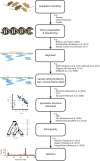The population genetics of crypsis in vertebrates: recent insights from mice, hares, and lizards
- PMID: 31399719
- PMCID: PMC6906368
- DOI: 10.1038/s41437-019-0257-4
The population genetics of crypsis in vertebrates: recent insights from mice, hares, and lizards
Abstract
By combining well-established population genetic theory with high-throughput sequencing data from natural populations, major strides have recently been made in understanding how, why, and when vertebrate populations evolve crypsis. Here, we focus on background matching, a particular facet of crypsis that involves the ability of an organism to conceal itself through matching its color to the surrounding environment. While interesting in and of itself, the study of this phenotype has also provided fruitful population genetic insights into the interplay of strong positive selection with other evolutionary processes. Specifically, and predicated upon the findings of previous candidate gene association studies, a primary focus of this recent literature involves the realization that the inference of selection from DNA sequence data first requires a robust model of population demography in order to identify genomic regions which do not conform to neutral expectations. Moreover, these demographic estimates provide crucial information about the origin and timing of the onset of selective pressures associated with, for example, the colonization of a novel environment. Furthermore, such inference has revealed crypsis to be a particularly useful phenotype for investigating the interplay of migration and selection-with examples of gene flow constraining rates of adaptation, or alternatively providing the genetic variants that may ultimately sweep through the population. Here, we evaluate the underlying evidence, review the strengths and weaknesses of the many population genetic methodologies used in these studies, and discuss how these insights have aided our general understanding of the evolutionary process.
Conflict of interest statement
The authors declare that they have no conflict of interest.
Figures


References
-
- Barbosa-Morais NL, Irimia M, Pan Q, Xiong HY, Gueroussov S, Lee LJ, et al. The evolutionary landscape of alternative splicing in vertebrate species. Science. 2012;338:1587–1593. - PubMed
-
- Barrett RDH, Hoekstra HE. Molecular spandrels: tests of adaptation at the genetic level. Nat Rev Genet. 2011;12:767–780. - PubMed
-
- Barrett RDH, Laurent S, Mallarino R, Pfeifer SP, Xu CCY, Foll MF, et al. Linking a mutation to survival in wild mice. Science. 2019;363:499–504. - PubMed
-
- Barron DG, Brawn JD, Weatherhead PJ. Meta-analysis of transmitter effects on avian behaviour and ecology. Methods Ecol Evol. 2010;1:180–187.
Publication types
MeSH terms
LinkOut - more resources
Full Text Sources

